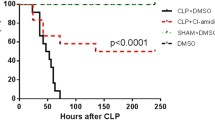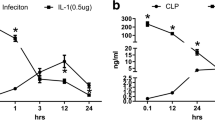Abstract
Due to the imbalance between hyper-inflammation and hypo-inflammation, which are characterized by excessive cytokine productions and programmed death 1 (PD-1) upregulation, respectively, sepsis remains a highly lethal inflammatory syndrome with limited effective therapies. Mycophenolate mofetil (MMF), an immunosuppressant, has been reported to attenuate various inflammatory diseases. However, the role of MMF in sepsis therapy remains to be elucidated. C57BL-6J mice underwent cecal ligation and puncture (CLP) and were treated either with or without MMF. Survival rate and organ injuries were compared. Cytokine levels, bacteria clearance, apoptosis of spleen and peritoneal macrophages, and PD-1 expression were assessed. At the beginning of CLP, 60 mg/kg MMF administered by gavage significantly protected septic mice, which was evidenced by improved survival and attenuated organ injuries, decreased cytokines, lower bacterial loads, and alleviated immune cell apoptosis. In addition, immune cells in the MMF mice showed lower PD-1 expression and improved immune response to pathogeny stimuli. MMF protects septic mice via the dual inhibition of cytokine releasing and PD-1 expression.







Similar content being viewed by others
References
Kumar, G., et al. 2011. Nationwide trends of severe sepsis in the 21st century (2000-2007). Chest 140 (5): 1223–1231.
Perner, A., et al. 2017. Sepsis: frontiers in supportive care, organisation and research. Intensive Care Medicine 43 (4): 496–508.
Ulloa, L., et al. 2009. Scientific and clinical challenges in sepsis. Current Pharmaceutical Design 15 (16): 1918–1935.
De Backer, D., et al. 2014. Pathophysiology of microcirculatory dysfunction and the pathogenesis of septic shock. Virulence 5 (1): 73–79.
Vincent, J.L., et al. 2013. Sepsis definitions: time for change. Lancet 381 (9868): 774–775.
Skirecki, T., et al. 2012. Sepsis immunopathology: perspectives of monitoring and modulation of the immune disturbances. Archivum Immunologiae et Therapiae Experimentalis (Warsz) 60 (2): 123–135.
Rabuel, C., and A. Mebazaa. 2006. Septic shock: a heart story since the 1960s. Intensive Care Medicine 32 (6): 799–807.
Hotchkiss, R.S., G. Monneret, and D. Payen. 2013. Immunosuppression in sepsis: a novel understanding of the disorder and a new therapeutic approach. The Lancet Infectious Diseases 13 (3): 260–268.
van der Poll, T., et al. 2017. The immunopathology of sepsis and potential therapeutic targets. Nature Reviews. Immunology.
Tao, X., et al. 2017. Interleukin 36alpha attenuates sepsis by enhancing antibacterial functions of macrophages. The Journal of Infectious Diseases 215 (2): 321–332.
Staatz, C.E., and S.E. Tett. 2014. Pharmacology and toxicology of mycophenolate in organ transplant recipients: an update. Archives of Toxicology 88 (7): 1351–1389.
Beduschi, M.G., et al. 2013. Mycophenolate mofetil has potent anti-inflammatory actions in a mouse model of acute lung injury. Inflammation 36 (3): 729–737.
Li, T., et al. 2014. Mycophenolate mofetil attenuates myocardial ischemia-reperfusion injury via regulation of the TLR4/NF-kappaB signaling pathway. Pharmazie 69 (11): 850–855.
Huang, X., et al. 2009. PD-1 expression by macrophages plays a pathologic role in altering microbial clearance and the innate inflammatory response to sepsis. Proceedings of the National Academy of Sciences of the United States of America 106 (15): 6303–6308.
Zhang, Y., et al. 2010. PD-L1 blockade improves survival in experimental sepsis by inhibiting lymphocyte apoptosis and reversing monocyte dysfunction. Critical Care 14 (6): R220.
Grant, C.R., et al. 2017. Immunosuppressive drugs affect interferon (IFN)-gamma and programmed cell death 1 (PD-1) kinetics in patients with newly diagnosed autoimmune hepatitis. Clinical and Experimental Immunology 189 (1): 71–82.
Rittirsch, D., et al. 2009. Immunodesign of experimental sepsis by cecal ligation and puncture. Nature Protocols 4 (1): 31–36.
He, S., et al. 2016. Annexin A2 modulates ROS and impacts inflammatory response via IL-17 signaling in polymicrobial sepsis mice. PLoS Pathogens 12 (7): e1005743.
van der Poll, T., and S.M. Opal. 2008. Host-pathogen interactions in sepsis. The Lancet Infectious Diseases 8 (1): 32–43.
Shindo, Y., et al. 2015. Interleukin-7 and anti-programmed cell death 1 antibody have differing effects to reverse sepsis-induced immunosuppression. Shock 43 (4): 334–343.
Xu, S., et al. 2012. Constitutive MHC class I molecules negatively regulate TLR-triggered inflammatory responses via the Fps-SHP-2 pathway. Nature Immunology 13 (6): 551–559.
Bally, A.P., et al. 2015. NF-kappaB regulates PD-1 expression in macrophages. Journal of Immunology 194 (9): 4545–4554.
Ward, P.A., and F. Fattahi. 2016. Editorial: Blockade of PD-1 and PD-L1 restores defective innate immune responses in leukocytes from septic humans. Journal of Leukocyte Biology 100 (6): 1229–1231.
Brown, K.A., et al. 2016. Targeting cytokines as a treatment for patients with sepsis: a lost cause or a strategy still worthy of pursuit? International Immunopharmacology 36: 291–299.
Deutschman, C.S., and K.J. Tracey. 2014. Sepsis: current dogma and new perspectives. Immunity 40 (4): 463–475.
van Vught, L.A., et al. 2017. The host response in patients with sepsis develo** intensive care unit-acquired secondary infections. American Journal of Respiratory and Critical Care Medicine 196 (4): 458–470.
Asberg, A., et al. 2010. Effects of the intensity of immunosuppressive therapy on outcome of treatment for CMV disease in organ transplant recipients. American Journal of Transplantation 10 (8): 1881–1888.
Assfalg, V., et al. 2010. Combined immunosuppressive and antibiotic therapy improves bacterial clearance and survival of polymicrobial septic peritonitis. Shock 33 (2): 155–161.
Li, J., et al. 2015. PD-1/SHP-2 inhibits Tc1/Th1 phenotypic responses and the activation of T cells in the tumor microenvironment. Cancer Research 75 (3): 508–518.
Monneret, G., M. Gossez, and F. Venet. 2016. Sepsis in PD-1 light. Critical Care 20 (1): 186.
Boomer, J.S., et al. 2011. Immunosuppression in patients who die of sepsis and multiple organ failure. JAMA 306 (23): 2594–2605.
He, X., et al. 2011. Mycophenolic acid-mediated suppression of human CD4+ T cells: more than mere guanine nucleotide deprivation. American Journal of Transplantation 11 (3): 439–449.
Funding
The work is supported by the National Natural Science Foundation of China (No. 81571931 to Er-zhen Chen, No. 81671901 to En-qiang Mao, No. 8167030165 to Jian Fei, and No. 81600501 to Ying Chen) and Shanghai Municipal Planning Commission of Science and Research Fund (No. 2016ZB0206 to Er-Zhen Chen).
Author information
Authors and Affiliations
Corresponding author
Ethics declarations
Conflict of Interest
The authors declare that they have no conflicts of interest.
Human and Animal Rights and Informed Consent
Animal studies were approved by the Animal Ethics Committee of Rui** Hospital affiliated with Shanghai Jiao Tong University, School of Medicine (No. 092), and were in strict agreement with the international guidelines for care and use of laboratory animals.
Rights and permissions
About this article
Cite this article
Huang, Sw., Chen, H., Lu, Ml. et al. Mycophenolate Mofetil Protects Septic Mice via the Dual Inhibition of Inflammatory Cytokines and PD-1. Inflammation 41, 1008–1020 (2018). https://doi.org/10.1007/s10753-018-0754-2
Published:
Issue Date:
DOI: https://doi.org/10.1007/s10753-018-0754-2




